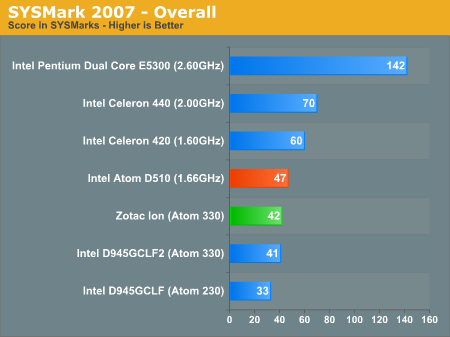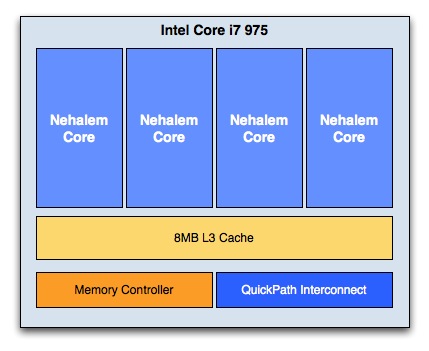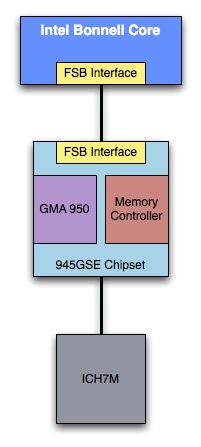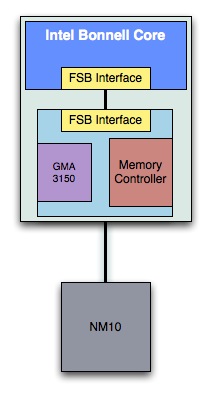Why Pine Trail Isn't Much Faster Than the First Atom
by Anand Lal Shimpi on January 27, 2010 12:48 PM EST- Posted in
- CPUs
In 2008 Intel introduced the Diamondville platform. This was the Atom platform that was used in the vast majority of netbooks and nettops. You had an Atom processor (codename: Diamondville) and Intel's 945GSE chipset. The memory controller was located on the chipset which was built on a 90nm process that ended up eating quite a bit of power.

Dual-core Atom "Diamondville" (left) vs. Dual-core Atom "Pineview" (right)
At the end of last year, Intel brought forth Pine Trail. Pine Trail used a new version of the Atom processor (codename: Pineview) and Intel's NM10 Express chipset. The memory controller was moved off the external chipset and on-die with the Atom processor. Graphics also made their way on die and the resulting 45nm chip consumed far less power than the old Atom + 945GSE combo.
When AMD integrated a DDR memory controller with the K8, we saw a big drop in memory latency and tremendous boost in performance. When Intel did the same with Nehalem the results were similar. Yet when we reviewed Pine Trail we saw virtually no drop in memory latency and very few situations where performance actually improved. In fact, it was only on the dual-core desktop Pine Trail system we reviewed that we saw any tangible performance gains.

Remember that Intel's Atom processor uses a dual-issue in-order architecture. As such you'd expect a huge boost from Intel integrating its DDR2 memory controller. After a bit of digging, we've finally figured out why that wasn't the case.
Unlike Nehalem, when Intel integrated the memory controller in Pineview it didn’t start with a brand new design. Here’s what Nehalem looks like from a high level:

The memory controller is on die and connects directly to the cache subsystem via some very low latency interconnects.
And here’s what Diamondville and Pine Trail look like:
Intel Atom "Diamondville" Platform 2008 | Intel Atom "Pine Trail" Platform 2009-2010 |
 |  |
Notice anything funny? There’s still a FSB interface between the CPU core and the memory controller. It’s all on die, but the Pineview CPU core still needs to go through the FSB unit before it can touch the IMC. That’s why the latency didn’t improve much, if at all. There are some improvements that do allow for better performance, but not what you'd expect from a redesigned, integrated memory controller.
Why would Intel do this? It saves time and thus money. Pineview literally uses the same Bonnell core as Diamondville but placed next to an on-die memory controller. A tightly integrated memory controller would require a redesigned version of the Bonnell core, something Intel wasn’t willing to commit to at this point.
Given the lack of competition from AMD or anyone else in the Atom space, it makes sense from a financial standpoint. Eventually Intel will have to redesign the core and tightly couple the memory controller, but I suspect that it won’t happen for a while. At least not until there’s real competition from AMD or someone from the ARM camp.










33 Comments
View All Comments
Inspector2211 - Wednesday, January 27, 2010 - link
Intel does not want to cannibalize sales of its Core 2 mobile chips (and its brand new "Arrandale" chips) by making Atom too fast.That said, just about a month from now the N470 Atom will be released - 1.83 GHz, up from the N450's 1.66 GHz. The N470 is the one to get. Forget the N450.
JarredWalton - Wednesday, January 27, 2010 - link
I don't think it's much of a concern. Even at 2.0GHz single core Atom is dog slow compared to any Core 2 processor. Atom is about low cost and low power; unless there are some real power savings to be had by improving the memory controller, there's not much point in working to improve Atom performance. What we should have gotten was something closer to the new Intel HD Graphics in Pine Trail; at least then it would be useful for a few more applications. Now we'll have to wait for Pine Trail + Broadcom Crystal HD.QuietOC - Wednesday, January 27, 2010 - link
My 1.4GHz Core 2 Solo SU3500 is sometimes slower than a 2GHz Atom core.I thought it was obvious that Pinetrail still retained the old Netburst FSB. It is basically Atom + die shrunk G31(aka P35/G33)--that actually should have been the original Netbook combo. Intel just didn't want to discount those chips at the time. Look at what they are now charging for "new" chipsets which are old 65nm southbridges!
JarredWalton - Wednesday, January 27, 2010 - link
Yes, Core 2 Solo. Never did quite get that CPU line, considering the Core 2 Duo is only a bit more and does substantially better in most areas. Even power doesn't favor the Core 2 Solo all that much.strikeback03 - Thursday, January 28, 2010 - link
Maybe I'm just looking in the wrong places, but it seems all the CULV dual-cores are $700 and up, while the single-core ones can be found for $500 or less. I wish the dual-core ones were only slightly more expensive.JarredWalton - Thursday, January 28, 2010 - link
Really like a lot of this... some will be put off by the 15.6" chassis, but that's the only drawback:http://www.amazon.com/Gateway-EC5409u-Notebook-PC/...">http://www.amazon.com/Gateway-EC5409u-Notebook-PC/...
11.6" model in red:
http://www.provantage.com/acer-lx-wf502-013~7ACEN0...">http://www.provantage.com/acer-lx-wf502-013~7ACEN0...
...or black (local pickup only):
http://www.microcenter.com/single_product_results....">http://www.microcenter.com/single_produ...ccode=ci...
...or at Amazon (for a bit more):
http://www.gateway.com/systems/product/529668399.p...">http://www.gateway.com/systems/product/529668399.p...
http://www.amazon.com/exec/obidos/ASIN/B0031RG0VM/...">http://www.amazon.com/exec/obidos/ASIN/B0031RG0VM/...
So the dual-core prices can range from close to $400 if you're lucky (Celeron SU2300 models) up to around $600. I think the Pentium SU4100 models are probably the best blend of price/performance for CULV right now.
QuietOC - Friday, January 29, 2010 - link
So compared to my $380 EC1803u: I would lose 100MHz and 1MB of cache with the same crappy screen and awful keyboard and trackpad.The GMA4500MHD is the only reason to get these, and that could work just as well with a faster Atom.
Jorgisven - Wednesday, January 27, 2010 - link
Could this be considered a tick in the Intel architecture, toward the 45nm process? Normally there are some performance improvements according to Intel's own website, http://www.intel.com/technology/tick-tock/index.ht...">http://www.intel.com/technology/tick-tock/index.ht.... But since the atom chip itself is already fairly small, they didn't change the process size, just crammed more into the same die, making it almost like a minor tock? Doesn't seem to follow their normal protocol. I hate when monopolies create situations like this, it lets companies get lazy.Inspector2211 - Wednesday, January 27, 2010 - link
What do you mean "towards the 45nm process" ???The Atom ***is*** 45nm.
I think you wanted to say "towards the 32nm process?" - and the answer is, since they are releasing Gulftown on 32nm just 1 1/2 months from now, implementing Atom on 32nm would have been a piece of cake, but was not done for cost/benefit reasons.
Taft12 - Sunday, January 31, 2010 - link
Right, why would Intel waste production on their newest and smallest process on a platform that is not very profitable and indeed eats into higher margin business (lost laptop CPU sales).Anand just explained why Pinetrail is not much better from a technical perspective, but from a business perspective, Atom performance is right where Intel wants it (in fact, I've postulated many times Intel wishes they had never released Atom at all).